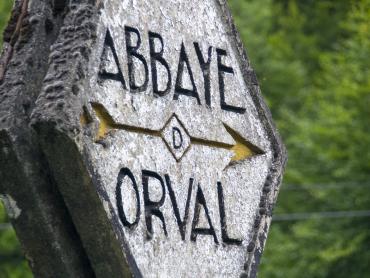Houx (Houx )
À Houx
A - Halte fluviale Voir sur la carte

Downwards Poilvache Fortress, you can stop a moment below the lock and enjoy the scenery offered.
À Houx
B - Poilvache Fortress Voir sur la carte
The year is 1214. By building this fortress, the Count of Luxembourg aimed to control the territory of Luxembourg, the boundaries of which were defined in the Treaty of Dinant in 1199. This treaty put an end to the conflict between Namur and Luxembourg. Building a castle opposite the powerful Count of Namur, represented by Bouvignes fortress and the town of Dinant, which depended on the Principality of Liège, was quite a challenge! So he made sure he had the necessary means. On the rocky spur, he had a huge fortress built, encompassing a town and surrounded by ramparts stretching over 300 metres. Poilvache was considered to be a real “state fortress”, so powerful that it struck its own coins! But its life was fleeting. The claims of the Count of Luxembourg hardly pleased the Prince Bishop of Liège. In 1430, the people of Liège and the people of Dinant laid siege to Poilvache… The castle was pillaged and sacked. The walls were demolished and used as a quarry: a grievous fate for a fortress that caused all the earldoms of the Middle Ages to tremble.
Chemin de Poilvache
5530 Yvoir
Tel : 0032(0) 82 61 36 82
Web : http://www.poilvache.be
Did you know?
The Trojan horse was emulated…To enter the fortress without attracting the attention of the besieged, the soldiers are said to have covered themselves with cowhides and hidden among the cattle as they returned.
Walk
To realise the extraordinary power once wielded by Poilvache, leave the village of Houx at its feet and climb the limestone hillside.
Practical details
Distance: 3 km
Waymarking: red and blue rectangle leading downwards
Difficulty: easy
Duration: 1h
Start: Go through the village of Houx, towards the cemetery. The path climbs towards the cemetery, running alongside the nature reserve. From the summit, you can return to Houx by following the blue and red rectangles.
À Houx
C - The nature reserve Voir sur la carte
The Champalle-Poilvache nature reserve covers 51 hectares on the slopes of the limestone cliff, facing south-west and on the wooded plateau. Southern plants and chalk grassland have been observed there: in Poilvache, you’d think you were in southern climes! Follow the path to explore this protected area, crossing the wooded plateau running along the edge of the cliff.















